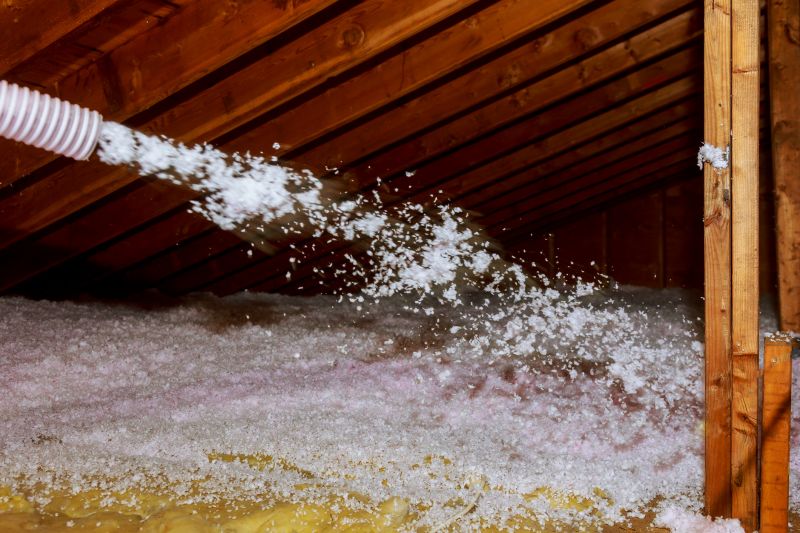Favorite Attic Insulation Replacement Solutions For Easy Upgrades
Choose from popular insulation products designed for straightforward installation and long-term attic performance.
 Attic insulation plays a crucial role in maintaining a comfortable indoor environment by regulating temperature and reducing energy costs. When existing insulation becomes old, compressed, or damaged, replacing it can help restore its effectiveness. The market offers a diverse array of products suited for various attic insulation needs, from traditional materials to modern solutions. Choosing the right product depends on factors such as insulation type, R-value requirements, ease of installation, and compatibility with existing structures. Proper selection and installation of insulation can enhance energy efficiency and indoor comfort.
Attic insulation plays a crucial role in maintaining a comfortable indoor environment by regulating temperature and reducing energy costs. When existing insulation becomes old, compressed, or damaged, replacing it can help restore its effectiveness. The market offers a diverse array of products suited for various attic insulation needs, from traditional materials to modern solutions. Choosing the right product depends on factors such as insulation type, R-value requirements, ease of installation, and compatibility with existing structures. Proper selection and installation of insulation can enhance energy efficiency and indoor comfort.
Top Overall Option
Fiberglass Insulation Batts and Rolls
Fiberglass insulation batts and rolls are versatile, widely available, and suitable for many attic insulation replacement projects. They are easy to handle and install, making them a popular choice for DIY homeowners. With a variety of thicknesses and R-values, they can be tailored to specific insulation needs. Properly installed fiberglass batts can help improve thermal performance and energy efficiency when used correctly.
Types of Products For Attic Insulation Replacements
Fiberglass Batts and Rolls
Pre-cut or continuous rolls of fiberglass insulation designed for easy installation in attic spaces.
Blown-in Cellulose Insulation
Loose-fill cellulose insulation for filling irregular attic spaces and existing cavities.
Blown-in Fiberglass Insulation
Loose-fill fiberglass for quick coverage and effective insulation in attics.
Spray Foam Insulation
Expanding foam that offers high R-value and airtight sealing, suitable for comprehensive attic upgrades.
Reflective or Radiant Barriers
Materials designed to reflect radiant heat, ideal for warmer climates.
Rigid Foam Board Insulation
High-density foam panels that provide continuous insulation and moisture resistance.
Mineral Wool Insulation
Fire-resistant insulation material with good soundproofing properties.
Reflective Foil Insulation
Thin reflective sheets that help reduce heat transfer via radiation.
Foam Board Insulation
Insulation panels that are easy to cut and install in attic spaces.
Insulation Foams and Sealants
Sprayable or applicator-based foam products for sealing gaps and cracks.
Reflective Insulation Wraps
Flexible reflective wraps for covering existing insulation or sealing attic spaces.
Cotton or Denim Insulation
Natural fiber insulation options that are safe and easy to handle.
Eco-friendly Insulation Materials
Insulation options made from recycled or natural materials, suitable for environmentally conscious projects.
Popular Choices
A common choice for DIY attic insulation replacement projects due to ease of installation.
Widely used for filling irregular spaces and existing cavities efficiently.
Preferred for air sealing and high thermal resistance in attic upgrades.
Popular for its high R-value and moisture resistance in attic applications.
Chosen in warmer climates to reflect heat and improve attic performance.
A trending option for quick and effective attic insulation coverage.
Gaining popularity for its fire resistance and soundproofing qualities.
Favored for its ease of installation and high insulation value.
Often used as a supplementary layer to existing insulation for heat reflection.
Popular for sealing gaps and cracks to improve overall insulation performance.
Different insulation materials come with unique properties, installation methods, and performance characteristics. Fiberglass batts and rolls are among the most common, offering straightforward installation for DIY enthusiasts. Blown-in insulations, which include cellulose and fiberglass varieties, are suitable for filling irregular spaces and existing cavities. Spray foam insulation provides excellent air sealing capabilities and high R-values, making it a popular choice for comprehensive attic upgrades. Reflective or radiant barrier insulations are also available to reflect heat away from the attic space, especially in warmer climates.
When considering replacement insulation, it is important to evaluate the existing attic structure, ventilation, and moisture control measures. Properly assessing these factors can help determine the most suitable type and thickness of insulation. Additionally, safety considerations such as protective gear during installation and compatibility with electrical wiring should be kept in mind. Regular inspections and maintenance ensure the insulation remains effective over time, preventing issues like mold growth or pest infestation. Investing in quality insulation products and proper installation can contribute to a more energy-efficient and comfortable home environment.
Key Buying Considerations
- Determine the appropriate R-value needed based on your climate and attic conditions.
- Choose insulation materials compatible with existing attic structures and ventilation systems.
- Consider ease of installation, especially if opting for DIY projects.
- Evaluate the safety measures required during installation, such as protective gear.
- Assess the moisture resistance and fire safety features of the insulation material.
- Check the size and thickness options to ensure proper coverage and fit.
- Look for products with good air sealing properties to enhance energy efficiency.
- Consider the environmental conditions, such as humidity and pests, that may affect insulation performance.
- Review local building codes and regulations related to attic insulation materials.
- Factor in the longevity and maintenance requirements of the insulation product.
- Determine whether additional accessories like vapor barriers or sealants are needed.
- Ensure the insulation material is suitable for the specific type of attic (unfinished, finished, etc.).
- Compare product reviews and ratings for insights into real-world performance.
- Think about budget constraints while balancing quality and durability.
